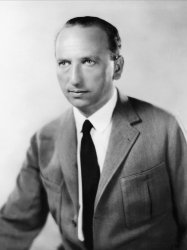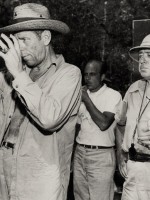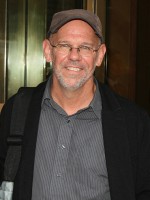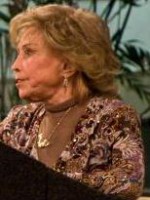Jay Ward est un Acteur et Scénariste Américain né le 20 septembre 1920 à San Francisco (Etats-Unis)

J Troplong "Jay" Ward (September 20, 1920 – October 12, 1989) was an American creator and producer of animated TV cartoon shows. He produced animated series based on such characters as Crusader Rabbit, Rocky & Bullwinkle, Dudley Do-Right, Peabody and Sherman, Hoppity Hooper, George of the Jungle, Tom Slick, and Super Chicken. His company, Jay Ward Productions, designed the trademark characters for the Cap'n Crunch, Quisp, and Quake breakfast cereals and it made TV commercials for those products. Ward produced the nonanimated series Fractured Flickers that featured comedy redubbing of silent films.
Jay Ward was raised in Berkeley, California, and he earned his undergraduate degree at the University of California at Berkeley. He also received an MBA from Harvard University. His first career was real estate. Even when his animation company was at the height of its success, he continued to own his own real estate firm as a "fallback" business. Jay Ward was married to Ramona "Billie" Ward. He had three children: Ron, Carey, and Tiffany. He and his wife collected African masks, and their collection is now part of the permanent collection of the Michelson Museum of Art in Marshall, Texas.
Animation career
Ward moved into the young mass medium of television with the help of his childhood friend, the animator Alex Anderson. Taking the character Crusader Rabbit to NBC-TV and the pioneering distributor of TV-programs, Jerry Fairbanks, they put together a pilot film, The Comic Strips of Television, featuring Crusader Rabbit, Hamhock Bones, a parody of Sherlock Holmes, and Dudley Do-Right, a bumbling Canadian Mountie.
NBC-TV and Fairbanks were both unimpressed with all but Crusader Rabbit. The animated series Crusader Rabbit premiered in 1949 and continues its initial run through 1952. Adopting a serialized, mock-melodrama format, it followed the adventures of Crusader and his dimwitted sidekick Rags the Tiger. It was, in form and content, much like the series that would later gain Ward enduring fame, Rocky and His Friends.
Rocky and Bullwinkle
Ward and Anderson lost the rights to the Crusader Rabbit character, and a new color Crusader Rabbit series under a different producer premiered in 1956. Ward then pursued an unsold series idea, The Frostbite Falls Revue. Taking place in a TV studio in the North Woods, the proposed series featured a cast of eccentrics such as newsman Oski Bear and two minor characters named Rocky the Flying Squirrel and Bullwinkle J. Moose, described in the script treatment as a "French-Canadian moose." This was the genesis of what would become Rocky and His Friends and later, The Bullwinkle Show, when NBC gave Rocky's sidekick top billing.
Premiering on ABC in 1959 (and moving to NBC two years later), the series contained a mix of sophisticated and low-brow humor. Thanks to Ward's genial partner Bill Scott (who contributed to the scripts and voiced Bullwinkle and other characters) and their writers, puns were used often and shamelessly: in a "Fractured Fairy Tales" featuring Little Jack Horner, upon pulling out the plum, Jack announced, "Lord, what foods these morsels be!" Self-referential humor was another trademark: in one episode, the breathless announcer (William Conrad) gave away the villain's plans, prompting the villain to grab the announcer from offscreen, bind and gag him, and deposit him visibly within the scene. The show skewered popular culture, taking on such subjects as advertising, college sports, the Cold War, and TV itself. The hapless duo from Frostbite Falls, Minnesota, blundered into unlikely adventures much as Crusader and Rags had before them, pursued by "no-goodnik" spies Boris Badenov and Natasha Fatale, perennially under orders to "keel moose and squirrel." The segments were serialized, generally ending on a cliffhanger; the announcer would urge the viewer to "tune in next time" for the next adventure, featuring two puns in the titles, like "Mine Eyes Have Seen the Gory, or, Moose's in the Cold, Cold Ground" and "When a Felon Needs a Friend, or, Pantomime Quisling." "Jay loved to hear me read the jokes out loud," Scott said in an interview. "I’d do all the voices. I’d never done this kind of thing, but I went through radio training when I was going to school in Denver."
In a running-joke tribute to Ward, many of his cartoon characters had the middle initial "J.", presumably standing for "Jay" (although this was never stated explicitly). The cartoonist Matt Groening later gave the middle initial "J." to many of his characters as a tribute to Jay Ward.
Ward fought many heated battles over content with the network and sponsor, but had little fear of censorship or lawsuits. The "Kirward Derby", a bowler hat that made everyone stupid and Bullwinkle a genius, was named (as a spoonerism) for Durward Kirby, sidekick of the 1950s and 1960s TV host Garry Moore and the co-host of Alan Funt's Candid Camera. When CBS tried to sue, Ward quipped, "We need the publicity. This was often a punchline in gags such as:
Rocky: "I think somebody's trying to kill us!"
Bullwinkle: "Well, don't worry. We'll be renewed."
Rocky: "I wasn't talking about the Bullwinkle Show."
Bullwinkle: "Well, you'd better! We could use the publicity!"
An eccentric and proud of it, Ward was known for pulling an unusual publicity stunt that coincided with a national crisis. Ward bought an island in Minnesota near his home and dubbed it "Moosylvania," based upon the home of his most famous TV character Bullwinkle. He and publicist Howard Brandy crossed the country in a van, gathering signatures on a petition for statehood for Moosylvania. They then visited Washington, D.C., and attempted to gain an audience with President John F. Kennedy. They arrived at the White House during the time of the Cuban Missile Crisis and were escorted off the grounds at gunpoint.
Early in his career, Ward was involved in two near-fatal incidents. He was run over by a car just outside his office, and he later received incorrect medical treatment while hyperventilating in an airplane. He then developed agoraphobia.
Source : Wikidata
Jay Ward

- Infos
- Photos
- Meilleurs films
- Famille
- Personnages
- Récompenses
Nom de naissance J Troplong Ward
Nationalité Etats-Unis
Naissance 20 septembre 1920 à San Francisco (Etats-Unis)
Mort 12 octobre 1989 (à 69 ans) à Los Angeles (Etats-Unis)
Fondateur de Jay Ward Productions
Nationalité Etats-Unis
Naissance 20 septembre 1920 à San Francisco (Etats-Unis)
Mort 12 octobre 1989 (à 69 ans) à Los Angeles (Etats-Unis)
Fondateur de Jay Ward Productions
Biographie
Early lifeJay Ward was raised in Berkeley, California, and he earned his undergraduate degree at the University of California at Berkeley. He also received an MBA from Harvard University. His first career was real estate. Even when his animation company was at the height of its success, he continued to own his own real estate firm as a "fallback" business. Jay Ward was married to Ramona "Billie" Ward. He had three children: Ron, Carey, and Tiffany. He and his wife collected African masks, and their collection is now part of the permanent collection of the Michelson Museum of Art in Marshall, Texas.
Animation career
Ward moved into the young mass medium of television with the help of his childhood friend, the animator Alex Anderson. Taking the character Crusader Rabbit to NBC-TV and the pioneering distributor of TV-programs, Jerry Fairbanks, they put together a pilot film, The Comic Strips of Television, featuring Crusader Rabbit, Hamhock Bones, a parody of Sherlock Holmes, and Dudley Do-Right, a bumbling Canadian Mountie.
NBC-TV and Fairbanks were both unimpressed with all but Crusader Rabbit. The animated series Crusader Rabbit premiered in 1949 and continues its initial run through 1952. Adopting a serialized, mock-melodrama format, it followed the adventures of Crusader and his dimwitted sidekick Rags the Tiger. It was, in form and content, much like the series that would later gain Ward enduring fame, Rocky and His Friends.
Rocky and Bullwinkle
Ward and Anderson lost the rights to the Crusader Rabbit character, and a new color Crusader Rabbit series under a different producer premiered in 1956. Ward then pursued an unsold series idea, The Frostbite Falls Revue. Taking place in a TV studio in the North Woods, the proposed series featured a cast of eccentrics such as newsman Oski Bear and two minor characters named Rocky the Flying Squirrel and Bullwinkle J. Moose, described in the script treatment as a "French-Canadian moose." This was the genesis of what would become Rocky and His Friends and later, The Bullwinkle Show, when NBC gave Rocky's sidekick top billing.
Premiering on ABC in 1959 (and moving to NBC two years later), the series contained a mix of sophisticated and low-brow humor. Thanks to Ward's genial partner Bill Scott (who contributed to the scripts and voiced Bullwinkle and other characters) and their writers, puns were used often and shamelessly: in a "Fractured Fairy Tales" featuring Little Jack Horner, upon pulling out the plum, Jack announced, "Lord, what foods these morsels be!" Self-referential humor was another trademark: in one episode, the breathless announcer (William Conrad) gave away the villain's plans, prompting the villain to grab the announcer from offscreen, bind and gag him, and deposit him visibly within the scene. The show skewered popular culture, taking on such subjects as advertising, college sports, the Cold War, and TV itself. The hapless duo from Frostbite Falls, Minnesota, blundered into unlikely adventures much as Crusader and Rags had before them, pursued by "no-goodnik" spies Boris Badenov and Natasha Fatale, perennially under orders to "keel moose and squirrel." The segments were serialized, generally ending on a cliffhanger; the announcer would urge the viewer to "tune in next time" for the next adventure, featuring two puns in the titles, like "Mine Eyes Have Seen the Gory, or, Moose's in the Cold, Cold Ground" and "When a Felon Needs a Friend, or, Pantomime Quisling." "Jay loved to hear me read the jokes out loud," Scott said in an interview. "I’d do all the voices. I’d never done this kind of thing, but I went through radio training when I was going to school in Denver."
In a running-joke tribute to Ward, many of his cartoon characters had the middle initial "J.", presumably standing for "Jay" (although this was never stated explicitly). The cartoonist Matt Groening later gave the middle initial "J." to many of his characters as a tribute to Jay Ward.
Ward fought many heated battles over content with the network and sponsor, but had little fear of censorship or lawsuits. The "Kirward Derby", a bowler hat that made everyone stupid and Bullwinkle a genius, was named (as a spoonerism) for Durward Kirby, sidekick of the 1950s and 1960s TV host Garry Moore and the co-host of Alan Funt's Candid Camera. When CBS tried to sue, Ward quipped, "We need the publicity. This was often a punchline in gags such as:
Rocky: "I think somebody's trying to kill us!"
Bullwinkle: "Well, don't worry. We'll be renewed."
Rocky: "I wasn't talking about the Bullwinkle Show."
Bullwinkle: "Well, you'd better! We could use the publicity!"
An eccentric and proud of it, Ward was known for pulling an unusual publicity stunt that coincided with a national crisis. Ward bought an island in Minnesota near his home and dubbed it "Moosylvania," based upon the home of his most famous TV character Bullwinkle. He and publicist Howard Brandy crossed the country in a van, gathering signatures on a petition for statehood for Moosylvania. They then visited Washington, D.C., and attempted to gain an audience with President John F. Kennedy. They arrived at the White House during the time of the Cuban Missile Crisis and were escorted off the grounds at gunpoint.
Early in his career, Ward was involved in two near-fatal incidents. He was run over by a car just outside his office, and he later received incorrect medical treatment while hyperventilating in an airplane. He then developed agoraphobia.
Le plus souvent avec
Filmographie de Jay Ward (5 films)
Acteur

To the Last Man (1933)
, 1h10Réalisé par Henry Hathaway
Origine Etats-Unis
Genres Romance, Western
Acteurs Randolph Scott, Esther Ralston, Buster Crabbe, Jack La Rue, Barton MacLane, Noah Beery Sr.
Note62%





Dans le Kentucky juste après la guerre civile, la querelle Hayden-Colby conduit Jed Colby à être envoyé en prison pendant 15 ans pour meurtre. Les Hayden se dirigent vers le Nevada et quand Colby sort de prison, il s'y rend également pour se venger. Le chef de la famille Hayden essaie d'éviter plus de meurtres, mais la confrontation inévitable doit se produire, compliquée par les projets de mariage de Lynn Hayden et Ellen Colby.

Goodbye Again (1933)
, 1h6Réalisé par Michael Curtiz
Origine Etats-Unis
Genres Comédie, Comédie romantique, Romance
Thèmes Adaptation d'une pièce de théâtre
Acteurs Warren William, Joan Blondell, Genevieve Tobin, Hugh Herbert, Wallace Ford, Helen Chandler
Rôle Theodore Clayton
Note62%





Anne Rogers est la secrétaire de Kenneth Bixby, un auteur de nombreux romans best-sellers. Lors d'une tournée de conférences, il rencontre Julie Wilson, une ancienne amie, qui croit qu'elle est la source d'inspiration pour son dernier roman. Ayant entendu parler de Bixby tout au long de son mariage, le mari de Julie le déteste, même s'il ne l'a jamais rencontré. Julie est déterminé à raviver leur romance, et pendant ce temps Anne prend soin du mari.

Reducing (1931)
, 1h17Réalisé par Charles Reisner
Origine Etats-Unis
Genres Comédie, Comédie dramatique
Acteurs Marie Dressler, Polly Moran, Anita Page, Lucien Littlefield, William Collier Jr., Sally Eilers
Rôle Marty Truffle
Note62%





The snobbish Madame Pauline "Polly" Rochay operates an exclusive beauty parlor in New York City that specializes in weight reduction. When she learns that her sister, Marie Truffle, is destitute, Polly decides to take her, her husband Elmer and their three children, Vivian, Jerry and Marty, from South Bend, Indiana, into her home. Joyce, Polly's socialite daughter, objects to her mother's decision, insisting that the Truffles are too unrefined to live among the Rochays. When the Truffles finally arrive in the big city, Polly puts her sister to work at her salon while Elmer looks for work as a mail carrier. Joyce resents the intrusion of the ill-mannered Truffles, and Polly concurs with her when the meddlesome Marie damages the beauty parlor and her children scratch her car. One evening, while Joyce is out on a date with her playboy sweetheart, Johnnie Beasley, Marie and Polly compare their daughters' boyfriends. Polly boasts that Johnnie is the better because he is a sophisticated millionaire, while Marie informs Polly that Tommy Haverly, Vivian's boyfriend, is from one of the oldest families in South Bend. Polly then insults Marie when she tells her that Vivian will never meet the same caliber of men that Joyce meets. When Johnnie brings Joyce home, he meets Vivian and takes an immediate liking to her, which makes Joyce jealous. The next day, after spurning Tommy, Vivian goes on a lunch date with Johnnie. Joyce later accuses Vivian of trying to steal her boyfriend. At the salon, Marie makes a nuisance of herself when, after a series of errors, she accidentally locks Polly in the steam room. Later, Polly and Marie become embroiled in their daughters' quarrel over Johnnie, and Marie strikes Joyce when Joyce insults Vivian. Three months pass, and the Truffles, now settled into their own home, await the arrival of Johnnie, who has been dating Vivian and will be escorting her to a party. While Vivian and Johnnie are out on their date, the heartbroken Joyce visits Marie and begs her to intervene in her daughter's affair with the man she loves. Moved by her show of emotion, Marie agrees to help Joyce by going to Johnnie's and speaking to him on her behalf. At Johnnie's, Marie accuses the young playboy of unfairly turning Vivian's head with fancy cars, yachts and other luxuries and then giving her the gate. Marie then insists that Johnnie marry Joyce, which he agrees to do. Marie tells her daughter that Johnnie was not worthy of her love because he was only seeing her to make Joyce jealous. After Joyce and Johnnie's wedding, Polly, unaware that Marie was responsible for their reunion, calls to gloat about the news and remind Marie that Vivian should have "stayed in her own class." However, when Joyce explains Marie's involvement, Polly thanks her sister for her help, and the two forgive each other.
Scénariste
 , 1h28
, 1h28Réalisé par Desmond McAnuff
Origine Etats-Unis
Genres Comédie, Fantasy, Action, Aventure, Animation
Thèmes Magie, Buddy movie, Films pour enfants
Acteurs Rene Russo, Jason Alexander, Piper Perabo, Randy Quaid, Robert De Niro, June Foray
Note42%





Rocky, brave petit écureuil volant, et Bullwinkle, un élan un peu niais, ont ravis les téléspectateurs pendant des années. Après l'interruption de leur émission, les deux vedettes animées sont tombées dans les limbes. Trente-cinq ans plus tard, le FBI décide de les tirer de leur retraite pour affronter leur ennemi de toujours, l'ancien dictateur de Pottsylvanie, Fearless Leader, qui tente de se faire élire à la présidence des États-Unis. Rocky et Bullwinkle ne se le font pas dire deux fois et foncent dans l'aventure.

Boris and Natasha (1992)
, 1h28Réalisé par Charles Martin Smith
Origine Etats-Unis
Genres Comédie, Action, Aventure
Acteurs Sally Kellerman, Dave Thomas, Andrea Martin, Paxton Whitehead, John Travolta, Christopher Neame
Note47%





The movie opens in the tiny country of Pottsylvania, located between the countries WrestleMania and Yoursovania, where Fearless Leader concocts a plan to obtain a time-reversal microchip, invented by Professor Anton Paulovitch. He asks his top agent, Agent X (whose face is obscured), to do the assignment, but Agent X suggests they send some patsies to find Paulovitch. Boris Badenov and Natasha Fatale accept their assignment to find the Professor, and are told to defect to America. After a number of failed attempts to get there (resulting in Fearless Leader having to save them many times), they make it to America, where they are sent to the CIA. The head of the CIA, Sheldon Kaufman, decides to have tests run on them to see if they are truly defecting. After the test, it's obvious to everyone that they should be deported, but a worker, Willie, points out they hadn't had any defects in a while, and thinks they should play along and in the meantime spy on them to see what they are after.
 Connexion
Connexion


